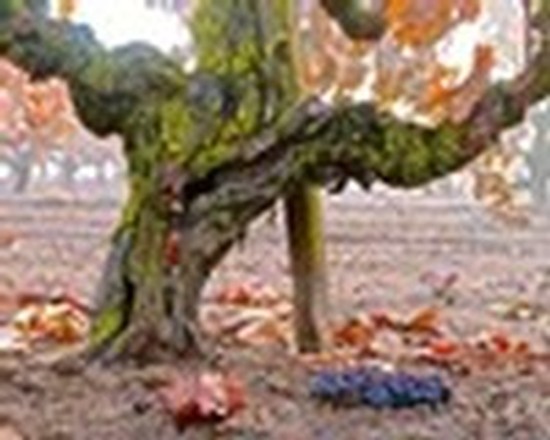Letters from Lodi
An insightful and objective look at viticulture and winemaking from the Lodi
Appellation and the growers and vintners behind these crafts. Told from the
perspective of multi-award winning wine journalist, Randy Caparoso.
Old vine plantings going into Lodi's best known vineyard-designate wines
Own-rooted Bishofberger Vineyard Carignan planted in 1936, in November 2020
Why older is better in Lodi
What are the Lodi AVA's old vine plantings identified as vineyard-designate wines on highly regarded Lodi-grown bottlings, and why do they matter?
They matter because of the precedent set in European wine countries a long, long time ago: the simple fact that the finest wine regions have always been associated with vineyards known to produce great wines.
In Lodi, the top vineyard-designate wines are primarily associated with “old vine” plantings—a distinction organizations such as the Historic Vineyard Society identify as "historic vineyards" dominated by plants that are at least 50 years old.
Old vines, in fact are almost a peculiarity of Lodi—there are more plantings over 50 years old in this AVA than in any other region in the U.S. The reason for this is that Lodi’s most distinctive wines have long been produced from grape varieties conducive to the region’s particular variation of Mediterranean climate. These particular grapes—especially Zinfandel and Carignan—also happen to be varieties known to benefit from vine age. The older the better!
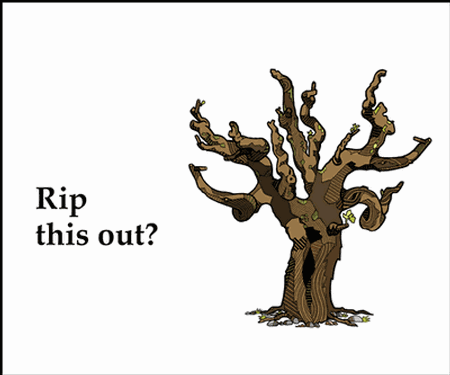
In most of the wine world, however, vine age is neither here nor there when it comes to vineyard quality or prestige. Napa Valley, for instance, is one, big favorable site, replete with great vineyards. However, the average age of vineyards in Napa Valley—now dominated by Cabernet Sauvignon, Chardonnay, Merlot, and smaller but significant amounts of Sauvignon Blanc—is well less than 20 years. That's because these vineyards are all on trellises, and trellised vines are routinely pulled out and replaced every 25 to 35 years. Why? Because trellised vines do not produce better wine as they get old, their productivity goes down. There's simply no reason to keep them in the ground to eventually attain "old vine" status.
Not so in a place like Lodi, where many of the best vineyards are associated with Zinfandel, Carignan, or Cinsaut planted before the 1970s. These vines are planted in the old way: as free-standing vines, held up by a single stake, with no trellis wires.
Tegan Passalacqua, the winemaker of Turley Wine Cellars, which produces over 30 vineyard-designate Zinfandels from 12 counties in California each year, has pointed out that in regions like Lodi, the oldest plantings that have survived the ups and downs of the past 100 or more years happen to be free-standing, spur pruned vines located on the most ideal sites. They have endured because they've remained healthy and productive.
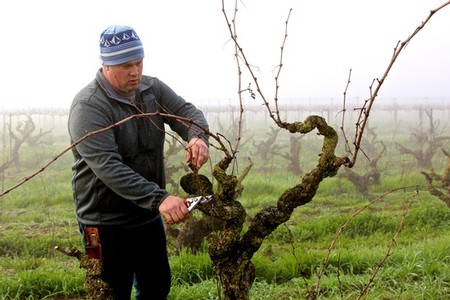
Turley Wine Cellars' Tegan Passalacqua pruning his Lodi property, Kirschenmann Vineyard (Zinfandel planted in 1915)
But there's more to it. Turley Wine Cellars, as it were, sources Zinfandel from vineyards of all ages—newly planted vines, vines 25 to 50 years old, 50- to 100-year years old vines and a good number of vineyards first planted over 100 years ago. According to Passalacqua, in our interviews over the years:
We pick our vineyards separately and keep the wines separate. Even in older vineyards that have large percentages of young, replanted vines, we will pick the young vines separately. So we produce wines made from the old vines, and wines from the younger vines. There are always differences, but one thing we always find, the best wines come from the oldest vines. We know this, and we can show you the chemistry to back it up.
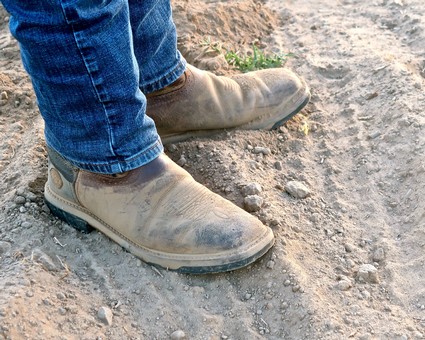
Ultra-fine sandy loam soil on the east side of Lodi's Mokelumne River AVA
East- vs. west-side Lodi plantings
Lodi growers and vintners have long known that there are differences in grape morphology and, ultimately, sensory qualities between old vine wines grown on the east side and old vine wines grown on the west side of the old Central Pacific Railroad tracks (now operated by Union Pacific Railroad) that run north-south, straight through Downtown Lodi, bisecting Lodi's Mokelumne River AVA. The distinctions are primarily soil-related, in this way:
• The sandy loam soil on the west side of the Mokelumne River AVA is generally richer in loamy, organic content.
• There is more sand content in east side soils, which increases drainage because of lower moisture-retaining capacity.
• There is also a deeper consistency of sandy loam on the east side, together with lower water tables.
The most direct impact of lower water tables and sandier soil on the east side is on the average cluster weight and berry size of grapes. Smaller berries and clusters mean higher skin-to-juice ratios, as well as earlier ripening, and both factors, can result in lower pH, higher total acidity , and increased phenolic content. Phenolic content derived from grape phenols and polyphenols affects the color and tannin as well as aromatic compounds of resulting wines.
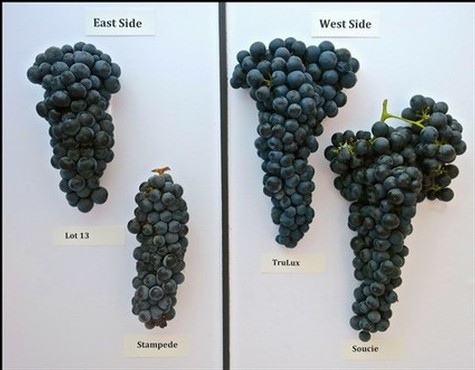
Comparison of cluster and berry sizes of Zinfandel grown on Lodi's east side vs. west-side, reflecting differences in soil depth and sand content
In plainer English, this means Zinfandels grown on Lodi's east side are generally zestier, more fragrant, and red fruit scented than Zinfandels grown on the west side. Zinfandel grown on the west side are generally fuller, broader, and rounder in feel, and replete with both red and dark fruit fragrances, as well as being earthier—with aromas tinged with loamy, occasionally mushroomy qualities—than east side Zinfandels.
It is not, however, a matter of one side's Zinfandel being "better" than the other. They're just different—something that a Lodi wine lover can judge for himself or herself by exploring the region's vineyard-designate bottlings.
Hence, our listing of Lodi's best-known old vine plantings, which we divide in this way:
1. West-side Mokelumne River AVA vineyards
2. East-side Mokelumne River AVA vineyards
3. East-side Clements Hills AVA vineyards
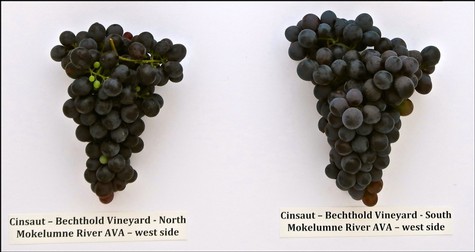
Comparison of Bechthold Vineyard Cinsaut cluster and berry sizes reflecting the influence of the Woodbridge water canal running along the south side of this vineyard, planted in 1886 on its roots
West-side Mokelumne River AVA growths
Bechthold Vineyard Cinsaut
• This 25-acre block consists entirely of own-rooted, spur-pruned, largely double-layered vertical cordon-trained Cinsaut, originally planted as “Black Malvoisie” by Joseph Spenker in 1886.
• It produces both soft, sumptuous reds and strikingly Provençal-style rosés by wineries such as Michael David Winery, Turley Wine Cellars, Bonny Doon Vineyard, Onesta Wines, McCay Cellars, Fields Family Wines, Jessie's Grove Winery, Estate Crush, The Scholium Project, Two Shepherds, BIRICHINO and Odisea Wine Company.
• While still owned by Joseph Spenker’s great-granddaughter Wanda Woock, this block has been managed and farmed organically by Phillips Farms since 2008.
• Bechthold Vineyard was named the 2014 California Vineyard of the Year by the California State Fair.
Marian’s Vineyard Zinfandel
• This revered 8.3-acre block of own-rooted, head trained Zinfandel was originally planted by the Mettler family in 1901 south of the City of Lodi along West Lane, north of Armstrong Road. It is now part of Mohr-Fry Ranches, owned and farmed by the Fry family.
• Stuart Spencer—owner/winemaker of St. Amant Winery, which has taken nearly the entire vineyard since 1999—has described these as Lodi's “mother of all vines,” an opinion with which few Lodi vintners would beg to differ.
• The combination of meticulous, LODI RULES-driven viticulture, exceptionally sandy soil with limestone lenses, or streaks, and a unique clonal selection has resulted in enduring vine health and strikingly different vine and cluster morphology, compared to adjoining Mohr-Fry Ranches Zinfandel blocks planted between 1941 and 1945. These vines still yield 2.5 to 4 tons per acre and produce a distinctively bold, concentrated style of Zinfandel somewhere between the floral, delineated styles of Lodi’s east side and the lush, round, earthier styles of Lodi’s west side.
• Vineyard-designate Marian’s Vineyard Zinfandels have been bottled under St. Amant since 1999 as well as Lodi Native labels.
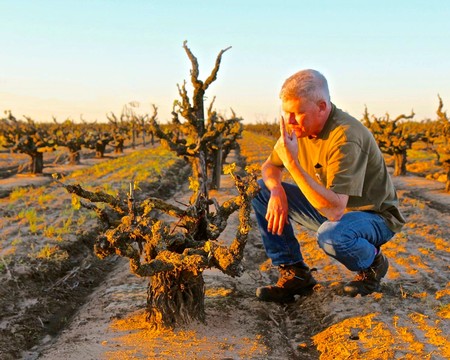
In Lodi's Soucie Vineyard (own-rooted, head trained Zinfandel planted in 1916), m2 owner/winemaker Layne Montgomery explaining why fruit from Soucie is #1 in his book
Soucie Vineyard Zinfandel
• This 100% own-rooted, head trained Zinfandel—its oldest block dating back to 1916—has been owned, planted and farmed by the Soucie family for three generations. Kevin Soucie is the current custodian.
• Located on the far western edge of the Mokelumne River AVA, closest to the Sacramento-San Joaquin River Delta, this block is known for its extremely fine, talcum powder-like variant of the Tokay series sandy loam soil, sometimes identified as Acampo series sandy loam.
• The growth and success of Lodi’s m2 Wines have been intertwined with Soucie Vineyard since the winery’s founding in 2002, although most of the Soucie Vineyard Zinfandel goes to Michael David Winery.
• In years past, Soucie Vineyard played a major part of Michael David’s top-of-the-line Lust Zinfandel and was one of the original seven properties going into the first 7 Deadly Zins bottlings.
• Soucie Vineyard has always produced one of Lodi’s most aromatic, fleshy, full-bodied yet well-balanced Zinfandels—think of the line by Bob Dylan about a “mattress balanced on a bottle of wine.” Its wines are pungent with red and black berried qualities tinged with unmistakably loamy/earthy, organic qualities.
• Vineyard-designate Soucie Vineyard Zinfandels are bottled by m2 Wines as Soucie Vineyard and Select Block (the latter, a reserve cuvée culled from specific rows receiving more leaf pulling and fruit dropping), as well as under m2's Lodi Native label. There is also a vineyard-designate Soucie Vineyard Zinfandel produced by PRIE Winery.
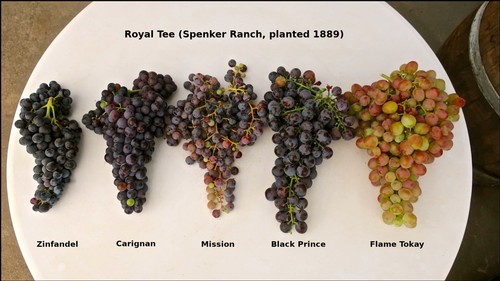
Field mix grown in Lodi's Royal Tee Vineyard, producing Zinfandels by Jessie's Grove and Alquimista Cellars
Wegat Vineyard Zinfandel
• This is the 21-acre “crown jewel” of the 330 acres farmed by the Maley family, close cousins of Michael David Winery’s Phillips family and all descendants of Andrew Harshner, who began homesteading on Lodi’s west side in 1869. The Malays were one of the seven growers comprising Lodi’s original 7 Deadly Zins.
• Wegat Vineyard is farmed by Todd Maley, the son of Joseph Maley who first established the Maley Bros. wine brand with his late brother Louis Maley.
• It consists primarily of spur-pruned, layered vertical cordon-trained vines planted in 1958 on St. George rootstock.
• Plant material was originally taken from an Acampo vineyard, a selection now prized by wineries such as m2 Wines, Oak Farm Vineyards and Macchia Wines for its consistently loose, fairly uniform, small-berried clusters.
• Wegat yields what is considered to be quintessential west-side Zinfandel, distinguished by flowery, red-towards-blue berried fruit qualities underlined by signature loamy/earthy undertones, and rounded, plush texturing.
• Wegat Vineyard Zinfandel is now bottled each year under Maley Bros.’s iteration of Lodi Native Zinfandel.
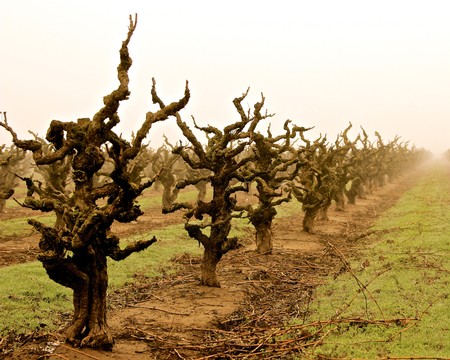
Wegat Vineyard Zinfandel, a quintessential west-side Lodi old vine growth
ZinStar Vineyard Zinfandel
• Zinstar was notably Lodi’s first single-vineyard estate bottling, starting with the 1978 vintage and bottled every year since by The Lucas Winery.
• The 3.5-acre block consists of spur pruned, double layered vertical cordon trained Zinfandel planted on its own roots in 1933. It is located in the heart of the Mokelumne River AVA’s west side, just east of the historic Spenker Ranch/Jessie’s Grove property, and north of West Turner Road.
• It is certified organic by California Certified Organic Farmers (CCOF).
• This vineyard produces a medium-bodied style of Zinfandel of moderate alcohol, zesty natural acidity, and distinctively earth-toned, lush fruit qualities, which results as much from a stylistic choice originated by owner David Lucas and continued by his spouse, winemaker/vineyard manager Heather Pyle Lucas, as from intrinsic terroir.
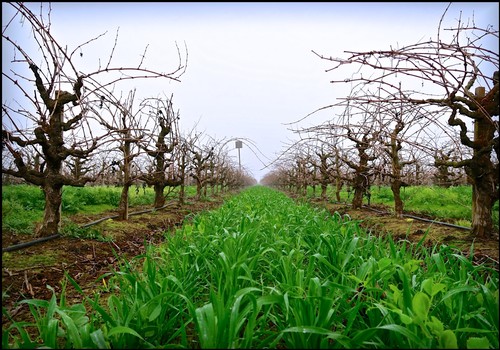
ZinStar Vineyard, the source of Lodi's first vineyard-designate Zinfandel bottling (a 1978 vintage)
TruLux Vineyard (Pescador Vineyard) Zinfandel
• Another one of Lodi’s most distinctive west-side vineyards, TruLux's 30 acres of Zinfandel on St. George rootstock are located less than a quarter-mile south of West Kettleman Lane, behind Van Ruiten Family Winery. Half the vines were planted during the 1940s, with an inter-planting of younger vines put in during the 1970s.
• The vineyard is owned and farmed by Keith Watts and has also been known as Pescador, the name of the Watts family’s late Filipino vineyard manager who originally planted and managed the vineyard.
• The vineyard is distinguished by unusually tall—even by Lodi standards, topping 6-foot—vertical cordon trained vines with a "cake” layering of spurs. It produces atypically small, loose, elongated clusters prized by wineries such as McCay Cellars (bottled as TruLux Vineyard), Watts Winery (bottled as Pescador Vineyard), and Michael David Winery.
• TruLux and Pescador vineyard-designate Zinfandels are distinguished by meaty, dark fruit qualities with smidgens of perceptible earthy/loam (but never herby or barnyardy) notes almost reminiscent of Southern French garrigue, couched in a balanced, medium-full body.
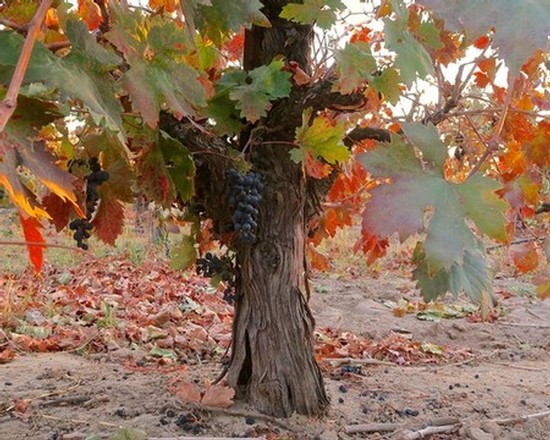
Second crop Zinfandel cluster hanging on tree-like vertical cordon trained TruLux Vineyard Zinfandel in early November
Royal Tee Vineyard Zinfandel
• The 5-acre Royal Tee Vineyard is Lodi’s oldest planting of Zinfandel. Planted on its own roots in 1889 by Joseph Spenker, it is still owned and farmed by one of Spenker's descendants, Greg Burns, who founded Jessie’s Grove Winery in the late 1990s.
• Royal Tee Vineyard also represents Lodi’s oldest surviving example of the classic, California style “field mix” of approximately 84% Zinfandel, with a balance of Carignan, Mission, Flame Tokay, and Black Prince (Rose of Peru). All vines are head trained and spur pruned.
• Up until 2017, Jessie’s Grove produced Royal Tee Zinfandel exclusively from Zinfandel vines isolated in the vineyard, with the Royal Tee Carignan and Flame Tokay grapes going into Jessie’s Grove Ancient Vine Carignane and Ancient Vine Tokay.
• In 2015 Alquimista Cellars, led by acclaimed winemaker/partner Greg La Follette, began harvesting and producing traditional “field crush” mixes of all five grapes, yielding exceptionally silken, zesty styles of Zinfandel with spiced floral notes almost suggesting white wine perfumes. In subsequent vintages, Jessie's Grove also began producing field-mix style Zinfandels from Royal Tee.
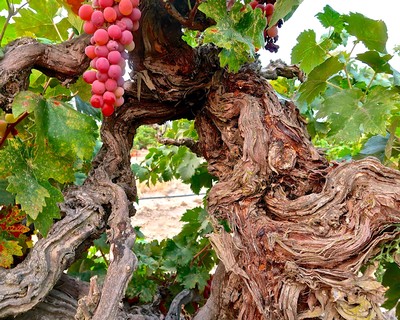
Ancient vine Flame Tokay, Mokelumne River-Lodi's iconic heirloom grapevine
Jessie’s Grove Block 4 Carignan, estate Zinfandel, and Flame Tokay
• An 8-acre block, called Block 4, of own-rooted Carignan originally planted along DeVries Road by Joseph Spenker in 1900, sitting on the western edge of the 320-acre (265 acres planted) Jessie’s Grove property.
• This Carignan planting, which has also been called the 1900 Block, yields the majority of fruit going into Jessie’s Grove’s perennially award-winning Ancient Vine Carignane, as well as bottlings by Holman Cellars, Leaf and Vine, Markus Wine Co.'s Domo and Zeitlos blends, Precedent Wine, Sandlands and Alquimista.
• At the center of the Jessie’s Grove estate is a second notable block of own-rooted, spur pruned Zinfandel planted in 1941 called Westwind Vineyard. It is bottled by Jessie's Grove as a vineyard-designate wine, producing a classic, full-bodied, dusty/earthy nuanced style of west-side Lodi Zinfandel. Most of Westwind's Zinfandel goes into Bogle Vineyards reds.
• Behind the old Spenker home is a small stand (less than half an acre) of Flame Tokay planted on their own roots in 1889, which goes into Jessie’s Grove’s White Port-style Ancient Vine Tokay.
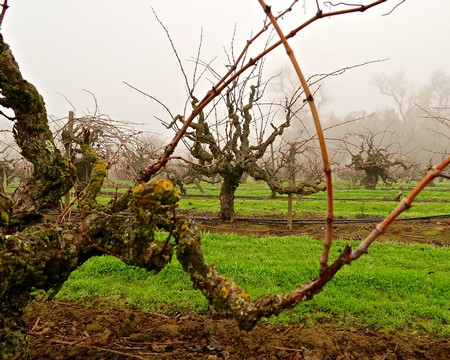
Lodi's oldest Zinfandel planting—Jessie's Grove's Royal Tee Vineyard, planted in 1889
Bonnotto Vineyard Zinfandel
• This own-rooted vineyard was planted in the 1930s by Ernie Spenker, a cousin of Joseph Spenker, and has been owned and farmed by the Bonnotto family since the 1950s.
• Typical of the Zinfandel blocks planted by this branch of the Spenker family along DeVries Road and south of West Turner Road, these spur-pruned vines are trained low to the ground (2- to 3-foot height) in a traditional goblet style.
• Since 2014, a Bonnotto Vineyard Zinfandel has been produced by McCay Cellars. The wine exhibits a somewhat meaty yet rounded, medium-full body with black and red fruit qualities, with a tinge of the dusty/loamy/earthy notes typical of Zinfandels grown on Lodi’s west side.
Bishofberger Vineyard Carignan
• This 12-acre block of own-rooted, vertical cordon Carignan was planted in 1936 just south of West Turner Road between DeVries and North Ray roads.
• It is owned and farmed by Bob Bishofberger, a close cousin to the Phillips family of Michael David Winery.
• Bishofberger Vineyard Carignan is occasionally bottled on its own by Michael David Winery, with the vineyard usually identified on the back label.
• This Carignan is typically between medium- to full-bodied (about 13.5% alcohol), retaining zesty natural acidity, moderate tannin and a classic red cherry varietal aroma with leafy/herby nuances.
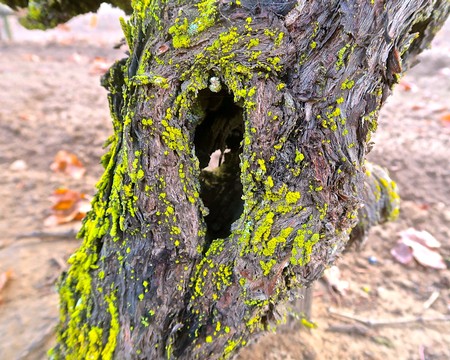
Completely hollowed-out trunk of Carignan in Bishofberger Vineyard, typical of old vine growths
Mohr-Fry Ranches Zinfandel
• In addition to their venerated Marian’s Vineyard, the Fry family owns and farms another 8 blocks of own-rooted Zinfandel planted over several years during the early 1940s. All are registered with the Historic Vineyard Society.
• The Fry family home ranch is located south of the City of Lodi, north of Armstrong Road, across West Lane from the Deshmesh Darbar Sikh Temple.
• Mohr-Fry is dominated by slightly sandier variations of the Tokay series sandy loam defining the Mokelumne River AVA, with unusual (for Lodi) limestone layers in the subsoil.
• Mohr-Fry Ranches’ Zinfandels are produced by St. Amant Winery, Oak Farm Vineyards, and several other wineries. They typically exhibit very “west-side” characteristics, with rounded, full-bodied, red and black fruit qualities, and tinges of dusty/loamy notes.
• Besides being leading exponents of LODI RULES for Sustainable Winegrowing, Jerry Fry and vineyard manager/son Bruce Fry were honored by the California Association of Wine Grape Growers as their 2016 "Grower of the Year."

Sixth-generation Lodi grower John Shinn of Shinn Ranch
Mule Plane Vineyard Carignan
• This 5-acre block of own-rooted Carignan, located on Davis Road less than a quarter-mile south of Peltier Road, was planted between 1927 and 1930 by the Shinn family. It is still owned by the same family and today is farmed by Shinn Ranch's sixth-generation managing partner John Shinn.
• The vineyard is called Mule Plane because it was originally leveled by mule and plow.
• These large spur-pruned, vertical cordon-trained vines—most reaching 6 feet—are historically high yielding, and still average more than 7 tons/acre.
• The grapes go into vineyard-designate Carignans produced by a number of small specialty wineries (m2 Wines, Precedent Wines, Holman Cellars, Leaf and Vine Winery, Bokisch's Tizona label, and BIRICHINO Winery).
• The vineyard is certified by LODI RULES for Sustainable Winegrowing and registered with the Historic Vineyard Society.
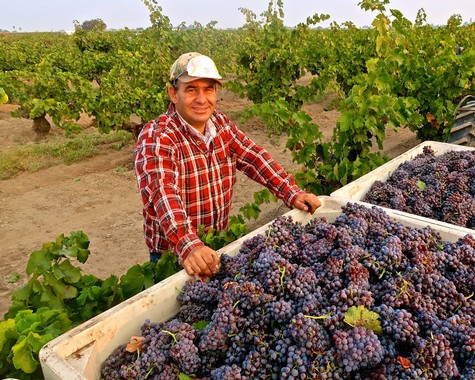
Manassero Vineyard manager Greg Manassero with 2020 Grenache harvested from 82-year-old own-rooted vines
Manassero Vineyard Zinfandel and Grenache
• 30-acre block of head-trained Zinfandel and Grenache (the latter, just 1 acre) owned and farmed by M.B. Manassero & Sons, located on Armstrong Road east of North Lower Sacramento Road, south of the City of Lodi.
• The original vines, all own-rooted, were planted in 1938-1939 by Joseph Manassero, who immigrated from Northern Italy in the early 1900s. Current vineyard manager Greg Manassero is a fourth-generation Lodi grower. Greg's father Leonard Manassero is a first cousin of the late Steve Borra, whose Borra Vineyards home vineyard is located just west of Manassero Vineyard.
• The west and west-north quadrants of the vineyard consists of Zinfandel planted in 1962 (own-rooted) and 1990 (grafted) respectively, and there is an east-north quadrant of Primitivo planted after 2010.
• Most of the Zinfandel goes to Bogle Vineyards and Michael David Winery. The old vine Grenache goes entirely to McCay Cellars.
• M.B. Manassero & Sons also owns and farms a separate 30-acre block of own-rooted 1961 Carignan and Zinfandel at Armstrong Road and North Ham Lane, and another 20 acres of own-rooted 1960 Carignan on Harney Lane at South Mills Avenue. All Manassero properties are certified by LODI RULES for Sustainable Winegrowing.
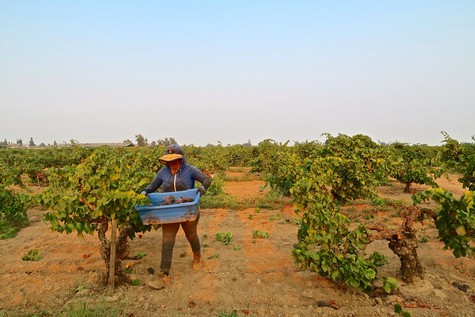
2020 old vine Grenache harvest in Manassero Vineyard
Hatterle Vineyard Zinfandel
• Hatterle's head trained, spur pruned Zinfandel vines are located off West Turner Road, and originally planted on their own roots toward the end of Prohibition in the 1930s.
• The vineyard has been farmed by Roland Hatterle since the late 1960s and now appears in vineyard-designate wines produced by Michael Klouda Wines in a contemporary, restrained, early-picked, terroir-focused style.
Star Valley Vineyard Zinfandel
• 8-acre block located on N. Davis Road at Larson Road, planted in 1962 and still owned and farmed by JW Moore Vineyards, a Lodi vineyard management company now in its fifth generation.
• Vineyard consists of own-rooted, vertical cordon trained Zinfandel, spur pruned in two-to-three layers.
• Registered by Historic Vineyard Society and LODI RULES certified.
• Grapes historically went to the Mondavi family of Charles Krug Winery; but since 2016, most of the fruit has been going to Lodi-based wineries, with a small portion bottled under JW Moore's own label, Alliance Winery (100% sourced from the vineyard, although the bottling does not carry a vineyard-designation).
•Star Valley produces a classic west-side Lodi style of Zinfandel—plump and round, with black cherry leaning towards blueberry and faint loamy earthiness.
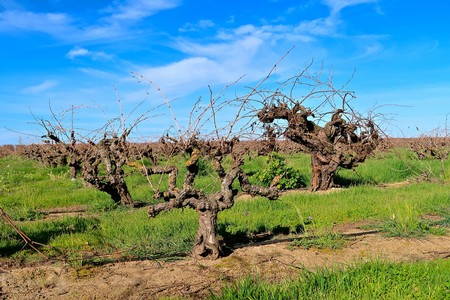
Own-rooted, 1940s-era Zinfandel growing alongside much larger Flame Tokay vine (typically, a much larger plant) on Lodi's east side
East-side Mokelumne River AVA vineyards
Most (not all) of the best known Mokelumne River-Lodi AVA vineyards east of the railroad tracks are located within the vicinity of the community of Victor, in a area that has been unofficially dubbed the "Victor Triangle." In the Victor area, the soil is almost beach-like in its sandiness—on a hot summer day, you almost want to lay out a blanket and umbrella.
A smaller number of the east-side old vine plantings fall in the Clements Hills AVA, east of the Mokelumne River area. Most of Clements Hills is, as the name suggested, hilly, and dominated by much older, shallow, gravelly clay soils. But on the bluffs that run along the Mokelumne River, which winds through the north end of Clements Hills, near the little communities of Lockeford and Clements, Lodi's found sandy soils similar to that of the flatter Mokelumne River area. This is where you find old vine Zinfandel planted primarily between the 1920s and 1940s.
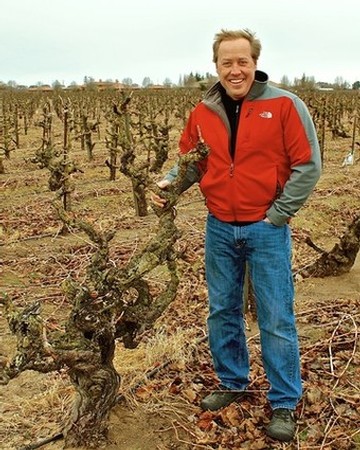
Harney Lane owner/grower Kyle Lerner with own-rooted 1904 Zinfandel in Lizzy James Vineyard
The east-side Mokelumne River AVA vineyards:
Lizzy James Vineyard Zinfandel
• This 20-acre vineyard located along Alpine Road, south of Highway 12 East and north of East Kettleman Lane, consists of own-rooted, classically head-trained Zinfandel dating back to 1904. The original vines are interplanted with more vigorous spur-pruned, vertical cordon vines planted mostly during the 1970s.
• This block sits on possibly the single sandiest site in the entire Mokelumne River AVA, the closest thing to beach-like sands in Lodi. As such, it is the most “east-side” of Lodi’s east-side vineyards.
• Owned and farmed by Harney Lane Winery, it produces a svelte, medium- to the full-bodied style of Zinfandel with ringing notes of cherry/raspberry, floral, and spiced tea scents, moderate tannin and consistent balancing acidity.
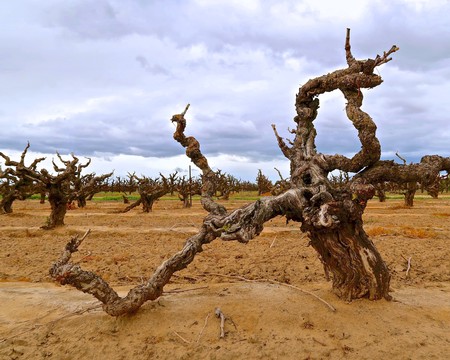
Extended spurs of head trained Scottsdale Vineyard Zinfandel during winter slumber
Scottsdale Vineyard Zinfandel
• Scottsdale Vineyard is a 2.5-acre, own-rooted, head trained Zinfandel block whose oldest vines date back to sometime in the early 1900s, with younger vines planted in the 1960s. It has been farmed over the past 15 years by Harney Lane Winery, which has owned it since 2013.
• The vineyard is located at the far western edge of the east side of the Mokelumne River AVA, along Scottsdale Road, between the railroad tracks east of West Lane and Highway 99. Vines grow in ultra-sandy soil yielding a small cluster morphology typifying east-side Lodi Zinfandel growths.
• Harney Lane co-owner/grower Kyle Lerner has always described Scottsdale as the “blueberry block” for the floral, blue and red berry-scented quality of the wine, similar to the fruit profile of Zinfandels grown in Rous Vineyard on Mokelumne River-Lodi's east side, south of Victor Road.
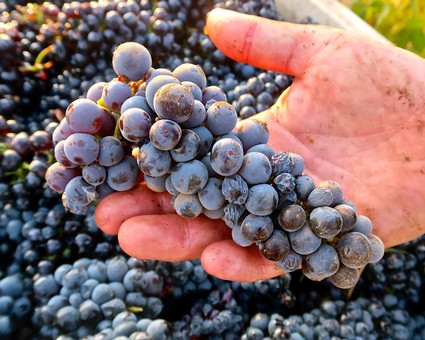
Typically small-clustered Kirschenmann Vineyard Zinfandel during the 2020 harvest
Kirschenmann Vineyard Zinfandel
• This 19-acre block of own-rooted, largely head-trained Zinfandel was originally planted in 1915 and farmed by Alan Kirschenmann until his death in 2004.
• It was known as Baumbach Vineyard up until 2012 when it was purchased by Tegan Passalacqua of Turley Wine Cellars from Sandy Laskey (née Kirschenmann). It is now farmed for Passalacqua by Arbor Vineyards, the vineyard management company associated with Mettler Family Vineyards.
• The vineyard is located just east of Bruella Road, south of Schmiedt Road, inside an oxbow curve of the Mokelumne River, circumstances that are said to have a significant impact on both the temperatures—a degree or two cooler than surrounding areas—and unique soil—streaks of limestone and silica found in the deep loamy sand. Adjoining McCay Cellars’ Lot 13 and Klinker Brick Winery’s Rauser Vineyard, this unique terroir accounts for the unusual number of surviving ancient vine plantings found in the vicinity. These Zinfandel blocks typically include smatterings of Alicante Bouschet, Carignan, Mondeuse noire and Grand Noir de la Calmette.
• Kirschenmann has become known for distinctively flowery, multifaceted fruit qualities—typically cherry, tea, and licorice/anise—and gentle, silken, layered styles of Zinfandels bottled by Turley Wine Cellars, Carlisle Winery, Arnot-Roberts, Bedrock Wine Co., Precedent Wine, and Passalacqua’s own Sandlands Wines label.
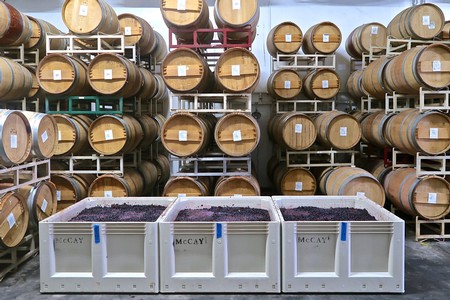
A ton and a half of Rous Vineyard Zinfandel just brought out of a 1-week cold soak to begin fermentation in McCay Cellars
Rous Vineyard Zinfandel
• This 10-acre block was planted in 1909 on St. George rootstock (one of the oldest in Lodi grafted onto Rupestris du Lot St. George). It is owned and farmed by Craig Rous, former director of the Kautz family’s Bear Creek Winery and Woodbridge by Robert Mondavi.
• The vineyard is located toward the center of the “Victor Triangle”—very close to Lewis Vineyard and Lizzy James Vineyard—a section characterized by deeper, sandier variations of Tokay sandy loam.
• It produces uniquely flowery (violet/blueberry) styles of Zinfandel with herby nuances and full, fleshy, rounded structures under the Ironstone Vineyards, Macchia Wines and McCay Cellars labels.
Lot 13 Vineyard Zinfandel
• These 10 acres of own-rooted, largely head trained, spur pruned Zinfandel were originally planted in 1915 on a patch of exceptionally sandy loam with limestone and silica layers at Schmiedt and Bruella roads, a stone's throw away from the Mokelumne River.
• The property was acquired by Michael McCay in 2013 from the Kirschenmann family and named for the original lot number (13) found on a 1906 Colonial Green Tract plat map.
• The vineyard is located in an oxbow-bend of the Mokelumne River where vineyards are surrounded by water on three sides and thus, dubbed “The Peninsula” by McCay. It lies near the north corner of the “Victor Triangle” and is separated by a dirt road from Kirschenmann Vineyard to the west and a tractor lane from Dairy Vineyard to the east.
• It is bottled by McCay Cellars as Faith and is also used in most of McCay’s bottlings of Lodi Native Zinfandel. In 2017, 2018 and 2019, a good amount of Lot 13 Zinfandel was picked for Ridge Vineyards for use in blends.
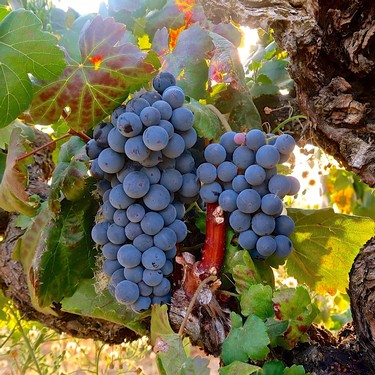
The black-pulped Alicante Bouschet grape, interplanted in all the east-side Carignan and Zinfandel vineyards located on Schmiedt Rd. (including Rauser, Kirschenmann and Lot 13)
Rauser Vineyard Carignan
• This Bruella Road vineyard is owned by Jeannie Rauser and is now managed by the Felten family of Klinker Brick Winery.
• It consists of mostly own-rooted, spur pruned, ancient vine Carignan planted in 1909, with a mix of equally old Alicante Bouschet and Zinfandel interplanted with recent Carignan replants.
• It is located in the heart of the Mokelumne River AVA’s east side, inside the “Victor Triangle,” right across Schmeidt Road from Tegan Passalacqua’s Kirschenmann Vineyard and kitty-corner to McCay Cellars’ Lot 13 Vineyard.
• Most of vineyard goes into Klinker Brick’s Carignane (medium-bodied, black cherry-scented reds with scrubby/earthy undertones), although a small portion of the fruit is picked earlier in the season, at lower sugars and higher natural fruit acidity, to go into dry rosés bottled by Klinker Brick.
Lewis Vineyard Zinfandel
• This own-rooted, thick-trunked, gobelet trained, ancient vine Zinfandel block was planted in 1903 about 50 yards west of Alpine Road, near Victor Road/Highway 12 East. It sits on a patch of particularly fine sandy loam that extends south into nearby Lizzy James Vineyard and west toward Rous Vineyard.
• It is owned and farmed according to LODI RULES for Sustainable Winegowing by Charlie Lewis, with all fruit going entirely to LangeTwins Family Winery & Vineyards.
• LangeTwins Family’s vineyard-designate Lewis Vineyard Zinfandel is typically meaty textured with red fruit, red licorice and black tea-scented fragrances, and a svelte, zippy, moderately weighted feel despite alcohol tipping into the 15% range.
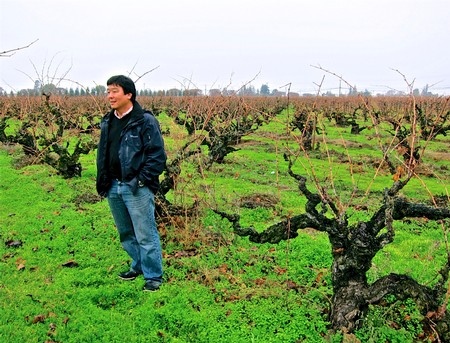
LangeTwins Family winemaker David Akiyoshi among ancient Lewis Vineyard Zinfandel plants
Marisa Vineyard Zinfandel
• This classic loamy sand/east-side site, located just east of the town of Victor on Highway 12 East, is owned and farmed by the Felten family of Klinker Brick Winery.
• The vineyard, originally planted in the mid-1920s, is a 50/50 split of own-rooted and Flame Tokay-rooted vines, the latter half grafted over in the late 1980s.
• It produces consistently refined, gentle, silky styles of Zinfandels, the opposite of “big” or bludgeoning, with distinctively floral raspberry/cassis-like perfumes.
Steacy Ranch Zinfandel
• This 40-acre block is owned and farmed by Turley Wine Cellars and located on the north side of Acampo Road, just east of North Kennifick Road.
• The oldest vines (about 21% of the vineyard) were planted in 1907. As such, they are the oldest Lodi Zinfandel vines of record planted on St. George rootstock, as opposed to the natural Zinfandel roots typifying the vast majority of pre-1960s Lodi Zinfandel growths.
Only the fruit from the oldest vines goes into Turley Steacy Ranch Zinfandel.
• Most of vineyard consists of Zinfandel plantings—also on St. George—dating back to the 1950s and '60s. It is also interspersed with Grenache, Carignan and Mission vines. Fruit from 50- to 60-year-old vines goes into Turley's Old Vines blend and their White Zinfandel. Most recently, some of the fruit has been going to Neyers Vineyards, while the vineyard's most recent replants, which are less than 25 years old, go into Turley's Juvenile program.
• The oldest vines produce zesty yet notably silken, fine-textured, vineyard-designate Zinfandels of moderate weight and "feminine" structuring, with flowery red fruit perfumes tinged with spice (pepper, thyme, allspice, etc.).
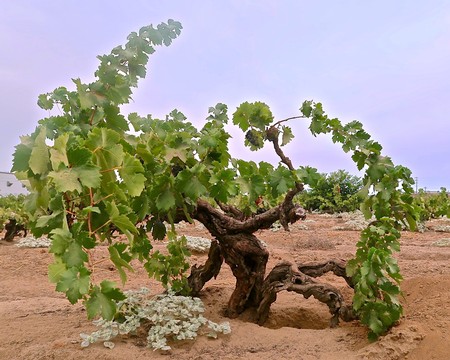
Very small, head trained Zinfandel in the dry-farmed Noma Ranch
Noma Ranch Zinfandel
• These own-rooted, spur pruned Zinfandel vines now comprise less than half of the original 15-acre plot in existence up until 2016. It was planted during the first decade of the 1900s south of Victor Road/Highway 12 East, across East Pine Street from Lodi Memorial Park & Cemetery.
• The vines are unusually small for Lodi, at 2 to 3 feet high. The site was dry farmed for over a century and vines are trained in the classic gobelet style, yielding largely fist-sized, tiny-berried clusters rarely adding up to more than 1 ton per acre.
• The vines were once farmed by Leland Noma, but are now tended by Mettler Family's Arbor Vineyards. Until recently the fruit was bottled exclusively by Macchia Wines under their Outrageous label, but now goes to Bedrock Wine Company in Sonoma.
• Noma Ranch traditionally produces a big—almost always close to 16% alcohol—concentrated style of Zinfandel with unusually high acid/tannin balance resulting from extreme skin-to-juice ratios and tiny cluster weights.
Dairy Vineyard (Schmiedt Ranch) Zinfandel
• This own-rooted, head trained, spur pruned Zinfandel was planted by the Schmiedt family in 1918 along the banks of the Mokelumne River where it is diverted north and bent into an oxbow, just east of Bruella Road, at the end of Schmiedt Road. The Schmiedt family still owns and farms this vineyard.
• The soil shares the common factor of exceptionally sandy, limestone-streaked alluvium with adjacent vineyards, notably Mike McCay’s Lot 13 Vineyard just to the west and Tegan Passalacqua’s Kirschenmann Vineyard another block over. Dairy produces styles of Zinfandel similar to Lot 13 and Kirschenmann—flowery, red cherry perfumes and zesty, moderate weights and tannins.
• Most of Dairy Vineyard’s fruit has been going to Turley Wine Cellars, although each year some of it is bottled under the Schmiedt family’s Twisted Roots 1918 label.
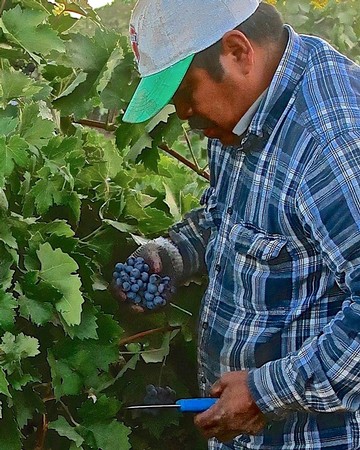
Zinfandel picker in Schmiedt's 1902 Zinfandel block
Schmiedt’s 1902 Zinfandel
• This postage-stamp-sized block, totaling 4 acres, consists of head-trained, own-rooted Zinfandel planted in 1902 on the Schmiedt family property between Bruella Road and Cherry Road (south of Schmiedt Road). It lies in the center of the east side’s “Victor Triangle,” defined by exceptionally fine, powdery, deep loamy sand.
• It is farmed by fourth-generation grower Galen Schmiedt, son of Carl Schmiedt and nephew of Ross and Leland Schmiedt.
• The fruit is now bottled as a vineyard-designate wine by Michael Klouda Wines in a contemporary, early-picked, terroir-focused style.
Cemetery Vineyard Zinfandel
• 7-acre vertical cordon trained vineyard planted on high-vigor Freedom rootstock ([solonis x Othello] x Dogridge) in the early 1980s.
The site, located across the road from Cherokee Memorial Park & Funeral Home (hence, the "Cemetery" moniker), sits on a pocket of extremely porous, deep, sandy soil, at the western edge of the sub-area of the Mokelumne River AVA unofficially called the Victor Triangle.
• The vineyard is owned and managed by Aaron Shinn, general manager of Round Valley Ranches. Fruit formerly went into Woodbridge by Robert Mondavi Winery's White Zinfandel program. In recent years, Shinn has been farming it for lower yields, going into the Zinfandel programs of local wineries such as Macchia, m2, and Oak Farm Vineyards.
• A past native yeast fermented vineyard-designate bottling by Oak Farm called "Indigenous" has demonstrated a moderately weighted, bright, zesty, finely textured varietal profile with red cherry/blueberry perfumes, not unlike Zinfandels from other Victor Triangle vineyards.
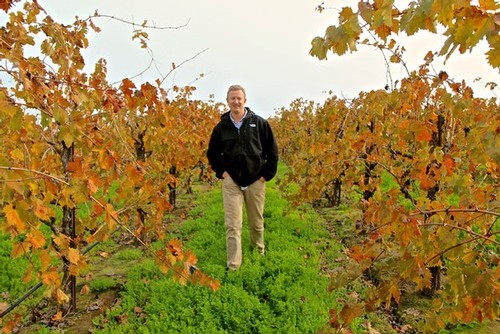
Aaron Shinn in his east-side Mokelumne River-Lodi AVA Cemetery Vineyard
East-side Clements Hills AVA vineyards
Dogtown Vineyard Zinfandel
• This 29-acre vineyard of own-rooted, head trained Zinfandel was originally planted in 1944, and has been managed by Turley Wine Cellars since 1997 on a long-term lease.
• Although located on a sloping site in the Clements Hills AVA, Dogtown is close enough to the Mokelumne River to retain a mix of fine and coarse sandy loam soils in the Cometa and Montpellier series. These soils are similar to the pulverized granite found in Lodi’s historic Mokelumne River vineyards, with a pale brick-colored clay loam.
• This unique terroir produces a consistently fine grained, lush red fruit and tea-nuanced Lodi-style Zinfandel, with a firm acid/tannin structure recalling the higher hillside-grown Zinfandels of nearby Amador County.
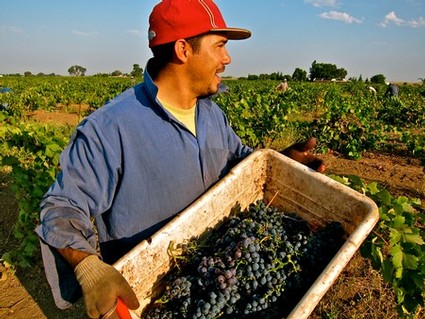
Dogtown Vineyard picker
Stampede Vineyard Zinfandel
• This Zinfandel block was planted in the 1920s and 1940s by J.J. Zechmeister and C.H. Süss on what was once a southern embankment of the Mokelumne River north of Highway 88 in Clements, adjacent to the Clements Buckaroos Rodeo Grounds. Soil types are dominated by Kingdon and Tokay fine sandy loams.
• The vines are primarily head trained, own-rooted Zinfandel, with smatterings of Mission and Mourvèdre, planted in an unusual diamond-shaped pattern with 9- to 10-foot by 10-foot spacing.
• Wines are produced as distinctive single-vineyard Zinfandels by Fields Family Wines as well under Fields Family's Lodi Native label. • These bottlings possess a notably firm acid/tannin edge similar to Sierra foothills-style Zinfandels, while retaining a roundness as well as red fruit (cherry/raspberry) fragrances typifying many Lodi-grown Zinfandels.
• The vineyard is owned and farmed by Jeff and John Perlegos with most of the fruit going to Bedrock Wine Co., and smaller amounts to a vineyard-designate bottling by Maître de Chai and Haarmeyer Wine Cellars.
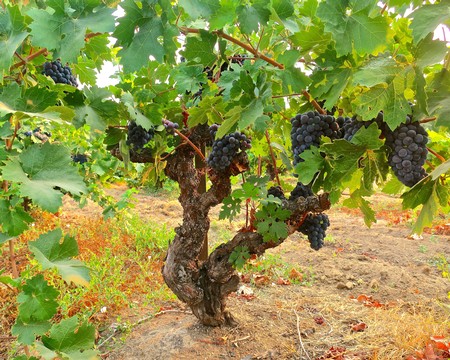
Small vine/cluster morphology characteristic of Süss Vineyard, planted in the late 1920s on an extremely sandy pocket of Clements Hills-Lodi
Süss Vineyard Zinfandel
• These 15 acres of own-rooted, head-trained, traditional goblet-shaped Zinfandel were planted during the late 1920s by C.H. Süss, south of Highway 88 between Lockeford and Clements, just east of Disch Road.
• The distinctive quality of this vineyard is that it lies in an uneven swale of particularly fine-grained, almost talcum powder-like loamy sand.
• Bokisch Vineyards has farmed and bottled the fruit as a vineyard-designate wine under their Tizona label since 2015, producing sturdy, medium-to-full-bodied Zinfandels with notably high natural acidity, silky fine textures, and floral notes of cherry and plum underscored by wild scrub-nuanced spice.
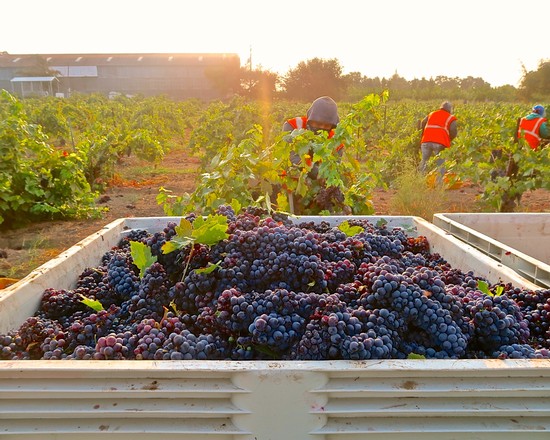
2020 Süss Vineyard Zinfandel harvest
